It’s Lupine Time
In this newsletter, I decided to spend much of our time together discussing an awesome perennial—lupine. My inspiration for doing this came from a recent article I read in one of my favorite newsletters, Tech On Demand by Bill Calkins. In the April 4, 2025 issue, Bill compiled an article titled, “Lupine Lessons Learned (and Shared)” that I'd like to share with you.
Rather than paraphrasing or highlighting a few key points in the article I thought it would be best to show it in its entirety.
Lupine Lessons Learned (and Shared)
I was looking through past grower interactions and problems addressed by the technical services team and saw a couple of issues tackled related to worrisome spots on lupine. The spotting appears to be most prominent on older leaves and my teammates who spoke with the growers said high feed was a commonality. This led to an assertion that the issue was nutrient-related.
Dark spots and splotching on older leaves are common symptoms for Fe/Mn toxicity, so if the crop has been over-fed, this is most likely the issue. Keeping a close eye on soil pH and EC is critical, and when corrected, the crop should rebound.
This got me thinking about lupines because they’re such a stunning impulse plant that shoppers have a hard time passing up at retail. I looked up tips for producing top-quality lupine and found a GROWERTALKS ARTICLE from a decade ago, written by a grower at Walters Gardens in Michigan. Here’s what they had to say regarding culture:
Moisture. Lupines prefer average soil moisture and require good drainage to thrive. Water them thoroughly and allow the soil to dry slightly between waterings. Plants that are held under wet conditions become prone to Anthracnose. It’s best to water in the morning and allow the foliage to dry before evening.
Lighting. Lupines require long days to flower. To force them into bloom earlier in the year, day-extension or night-interruption lighting can be effective.
Temperature. If starting your lupines in the fall, grow them under natural temperatures, but maintain air temperatures above 50F (10C) until plants are rooted in. Once they’re well-rooted, they can be shut down for winter and vernalized for six to eight weeks or longer under 40F (4C) in minimally heated greenhouses or unheated cold frames. If growing lupines in spring, grow them cool at 60 to 65F (15 to 18C) constant air temperatures.
Growing media and fertility. Lupines prefer to be grown in a well-drained, bark-based growing mix, which allows for better drainage. They don’t like heavy soils. A slightly acidic pH of 5.8 to 6.2 is best in production. Lupines are light to moderate feeders. Fertilize with a constant liquid feed of 75 to 100 ppm nitrogen at every irrigation, or 150 to 200 ppm nitrogen as needed. If using a controlled-release fertilizer mixed into the growing media, use at a medium rate of 1 lb./cubic yard. The recommended EC rate using the pour-through method is 2.0 to 2.5.
Pests and diseases. Lupines can be affected by several insect and disease issues, so it would be wise to maintain a preventative spray rotation on a biweekly basis. Scout for aphids, whiteflies and thrips, treating as necessary. Also watch for downy mildew, powdery mildew, Anthracnose and rust. Drenching plants with a broad-spectrum fungicide at transplant can help to prevent disease. Crown and root rots can be prevented by not growing plants wet, especially at night.
I'd like to thank Bill for putting together this informative article on lupine.

Lupine Diseases
At the risk of making lupine appear difficult to grow (because they’re not) or that they're plagued by diseases, I thought I’d take a moment to pass along a couple diseases not really covered in detail in the article above. The two pathogens I’m referring to are Colletotrichum (Anthracnose) and Fusarium.
|
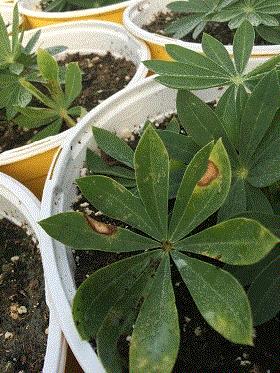
Colletotrichum
|
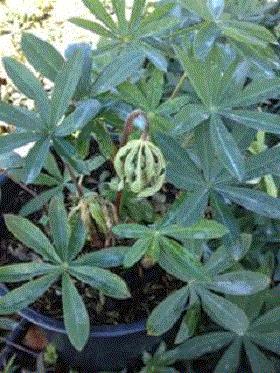
Fusarium
|
Colletotrichum (above left) is typically a leaf spot disease that forms half-moon shapes on the edges of the leaves. This disease can also progress to cause cankers on stems and kill entire branches. This pathogen has been shown to be seed borne, so plants may be at a disadvantage even before they germinate. However, it’s not exclusive to seed cultivars and can also infect culivars starting from tissue culture.
Many growers naturally assume when the plants collapse that Colletotrichum is that culprit; this isn't necessarily the case. When you see wilt symptoms, don’t just assume you have Anthracnose. Plants with blighted or wilted leaves are commonly infected with Fusarium (above right). Fusarium is a crown/stem rot, which causes the leaves and stems to collapse, often killing the entire plant. It’s not uncommon for lupine to be infected with both of these pathogens at the same time.
The most effective fungicides for controlling Colletotrichum and other Anthracnose diseases are Orkestra, Aveylo and Spectro. Rotate these products at seven- to 10-day intervals until the progression of the symptoms have stopped.
The Anthracnose rotation listed above will go a long way towards preventing Fusarium, as well. If you're targeting Fusarium specifically, a great rotation would be Orkestra, Medallion and Daconil. Daconil cannot be drenched, but it can be applied as a heavy spray.
For both of these pathogens, it’s best to apply these fungicides on a preventative basis before symptoms are present.

The Brighter Side of Lupines
After reading about some of the problems lupines can get, it doesn’t mean that they'll get these issues or that they can’t be managed. Lupines are a very impressive perennial and I think it’s time I shift the focus to the beauty these perennials offer. Here are several wonderful cultivars available:
|
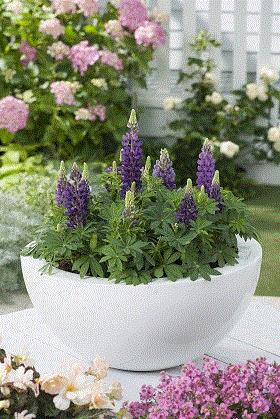
Mini Gallery Blue
|
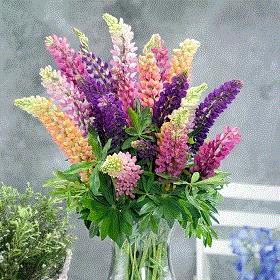
Russell Hybrids Mix
|
|
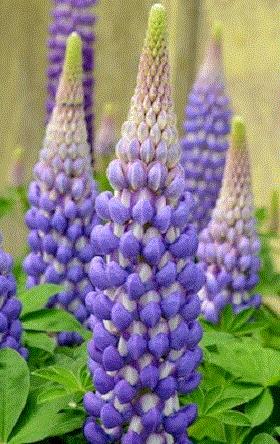
Westcountry Persian Slippers
|
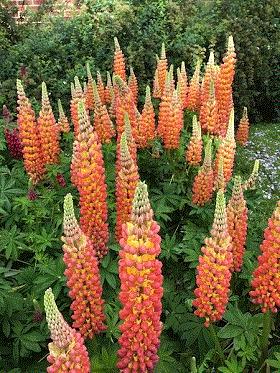
Westcountry Gladiator
|
|
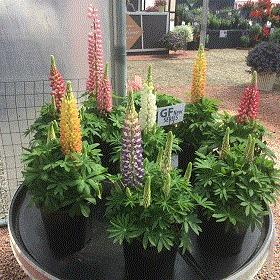
Staircase series
|
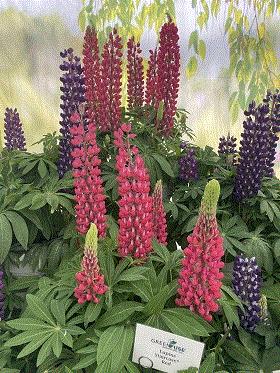
Staircase Red, Staircase Dark Blue/White
|
Summer Perennial Events
Walters Gardens 2025 Perennial Expo
Walters Gardens is hosting their one-day Perennial Expo on Tuesday, June 17, 2025 at its main growing facility in Zeeland, Michigan. Here's what’s on the agenda:
-
Perennials Aren’t Just Plants—They’re People, Too! (Keynote) Rick Vuyst, co-host of the Gardening Simplified Show
-
Planning, Productivity & Workflow Management: Is it Possible to be Accurate? Ryan Hop, Walters Gardens COO
-
In Case You Missed it (Recent Walters Gardens plant intros) Cayla Olson, Regional Product Manager—Walters Gardens
-
Innovations in Bloom: Plant Introduction Highlights for the 2025-2026 Season Hans Hansen, Director of New Plant Development—Walters Gardens
-
Boost Sales With a Strong Fall Perennial Program Laura Robles, Regional Product Manager—Walters Gardens
-
Potting Perfection: Pro Tips for Top-Quality Finished Containers Jessie Carle, Trials Manager—Walters Gardens
-
Seeds of Success: Improving Home Gardener Engagement Through Strategic Programs Andrew Jager, Marketing Manager—Walters Gardens
-
Greenhouse and facility tours
-
Display garden tours
Wow, this looks like an incredible day!
Darwin Perennials Day
Darwin Perennials will be hosting Darwin Perennials Day the next day (Wednesday June 18, 2025) in West Chicago, Illinois. Being three hours apart, it’s no coincidence Walters Gardens and Darwin Perennials host these events back to back. You can easily attend both of them. Here’s what's on the Darwin Perennials Day agenda:
-
Stroll through the extensive perennial gardens
-
Visit the new varieties showcase
-
See the cut flower bed and meet Dave Dowling, Cut Flower Specialist
-
Visit the education stations
-
Meet with more than 25 suppliers
-
Visit with Darwin Perennials product experts
-
Panel Discussion: "Stop Stressing About Perennial Production"
Tours
-
Interactive video tour of Darwin Colombia
-
Vegetative farm
-
Ball's new Seed Distribution Facility
-
The Perennial Gardens

The Big One

If you’re passionate about perennials and looking for a perennial-focused venue (it’s more like an experience), then I have an event for you—and I’d even say it’s the big one. It’s none other than the Perennial Plant Association’s (PPA) 2025 National Symposium. It’s being held from July 28-31, 2025 in the heart of the Midwest—Des Moines, Iowa.
There are too many tour locations (15 in all) and educational sessions to list them all, but here’s a few that caught my interest:
|
Tours
-
Greater Des Moines Botanic Garden
-
Better Homes & Gardens Test Garden
-
Robert D. Ray Asian Garden
-
Three Oaks Garden (Norris & McKinney Private Garden)
-
Neal Smith National Wildlife Refuge
-
Brandy and Mosa Shayan Private Garden
-
The Harkin Institute
|
Educational Sessions
-
Landscapes that Connect Gardening Communities With Perennial Plants Wambui Ippolito, Wambui Design
-
Designing Landscapes of Place Darrel Morrison, University of Wisconsin
-
Propagating Native Prairie Plants Bob Henrickson, Nebraska Statewide Arboretum
-
Strategies for a Thriving Fall Perennial Program Panel Bryan Benner, Quality Greenhouses & Perennial Farm Inc.; Chris Fifo, Darwin Perennials & PanAmerican Perennials; Thad Kohlenberg, Willoway Nurseries, Inc.; and Laura Robles, Walters Gardens
|
The early bird registration deadline is June 10, 2025 and final registration deadline is July 15, 2025.





My email is paul@opelgrowers.com if you have any comments, article suggestions or if you'd just like to say hello.
Best regards,

Paul Pilon
Editor-at-Large—Perennial Pulse
Director of Growing—Opel Growers
This email was received by you and 34,268 other fine subscribers!
If you're interested in advertising in Perennial Pulse, contact Kim Brown ASAP and she'll hook you up.